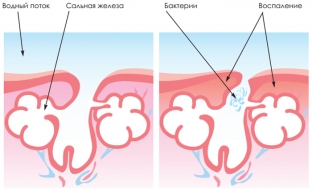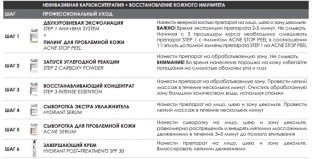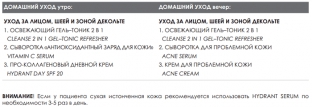The task of the sebaceous glands is to produce sebum, which is designed to protect and strengthen the skin. However, due to improper care, the negative impact of environmental factors, hormonal levels and improper nutrition, the sebaceous glands begin to work incorrectly, which leads to the appearance of acne. Chronic course, frequent relapses and resistance to ongoing therapy – frequent cases among patients with acne.
Products designed to correct problematic skin are effective in treating acne on the face by restoring the normal process of sebum formation, suppressing inflammation and narrowing enlarged pores. Result – skin texture and color are normalized, comedones disappear.
Provoking factors causing acne on the face
Acne is a chronic inflammatory disease characterized by clogged sebaceous glands and increased sebum production.
Acne can appear on both oily and normal skin.
Factors contributing to the development of acne:
- hormonal status (with an increase in the level of androgens, the sebaceous glands work in a mode of increased intensity, showing particular sensitivity to such hormones);
- zinc deficiency (the less zinc in the patient's body, the more pronounced acne due to the activity of 5α-reductase);
- hot and humid climate;
- stress (increased production of male androgen hormones, which is triggered by the pituitary gland in a state of stress, leads to increased secretion of sebum);
- certain medications;
- Cosmetic ingredients that block pores and cause skin irritation;
- pathology of lipid metabolism (a high level of free fatty acids on the surface of the skin is observed as a result of changes in the biochemical composition of sebum);
- mechanical "manual cleaning" procedures.
For successful treatment of acne on the face, it is very important to make an early diagnosis, conduct a correct clinical assessment and timely prescribe effective and safe drugs based on the clinical form of the disease.
We'll look at the features below:
- acne pathogenesis and definition of the form of the disease;
- mechanism of skin acne treatment.
Pathogeny of acne on the skin and determination of the severity of the disease
The main components of the pathogenesis of acne on the face are:
- Sebum overproduction
This problem is typical for seborrhea. Most of the sebaceous glands are located in the T-zone (forehead, wings of the nose, chin). The hypersecretion of sebum may appear due to increased levels of androgens and/or density of sebocyte receptors.

- Follicular hyperkeratosis
Follicular hyperkeratosis is a violation of the processes of keratinization in places where the excretory ducts of the sebaceous glands open – orifices of hair follicles. As a result of hyperkeratosis in the sebaceous gland, outflow is disturbed and secretion accumulates, which leads to the formation of microcomedones and, over time, a cystic cavity in the follicle.
- Activation of bacterial flora and inflammation
Despite the fact that the bacteria themselves are not the cause of acne on the face, they play a role in local inflammatory processes, multiplying inside the crown of the follicle. Proteolytic enzymes secreted by the bacteria P. acne break the permeability of the epithelium and provoke inflammation due to the entry of the contents of the follicle into the dermis.

Effective mechanisms for the treatment of acne on the face
The preliminary treatment plan, which consists of the following items, is determined by the physician after the clinical diagnosis is made.
- Cleanse and detox.
- Keratolytic therapy.
- Anti-inflammatory and antimicrobial therapy.
- Sebum normalization.
- Restoration of water-lipid balance.
For effective treatment of acne on the face, a dermatocosmetologist must collect all information about the patient's health, conduct a complete clinical examination and send for the necessary tests.
MEDICARE recommends the following programs for the pathogenetic treatment of acne on the face:
- 1, 2 degree: ACNE STOP PEEL peeling + carboxytherapy (normalizes sebum production, reduces inflammation and irritation, improves skin hydration, restores skin structure and tone).
- 1, 2 degree: course of treatment with retinoids + carboxytherapy (ensures the normalization of keratinization processes, enhances the proliferation of epitheliocytes, reduces sebum secretion and inflammation).
- 2, 4 degree: benzoyl peroxide + carboxytherapy (provides complete restructuring of the skin, restoration of the protective function of the skin, stimulation of the proliferation of healthy cells through desquamation and removal of toxins).
The course of the BETA FACIAL PROGRAM procedure for effective acne treatment:

Home care products:

The pathogenetic treatment program for acne on the face, developed by MEDICARE, combines high efficiency and safety, providing the desired result – complete elimination of acne and normalization of the condition of problem skin.









Add a comment